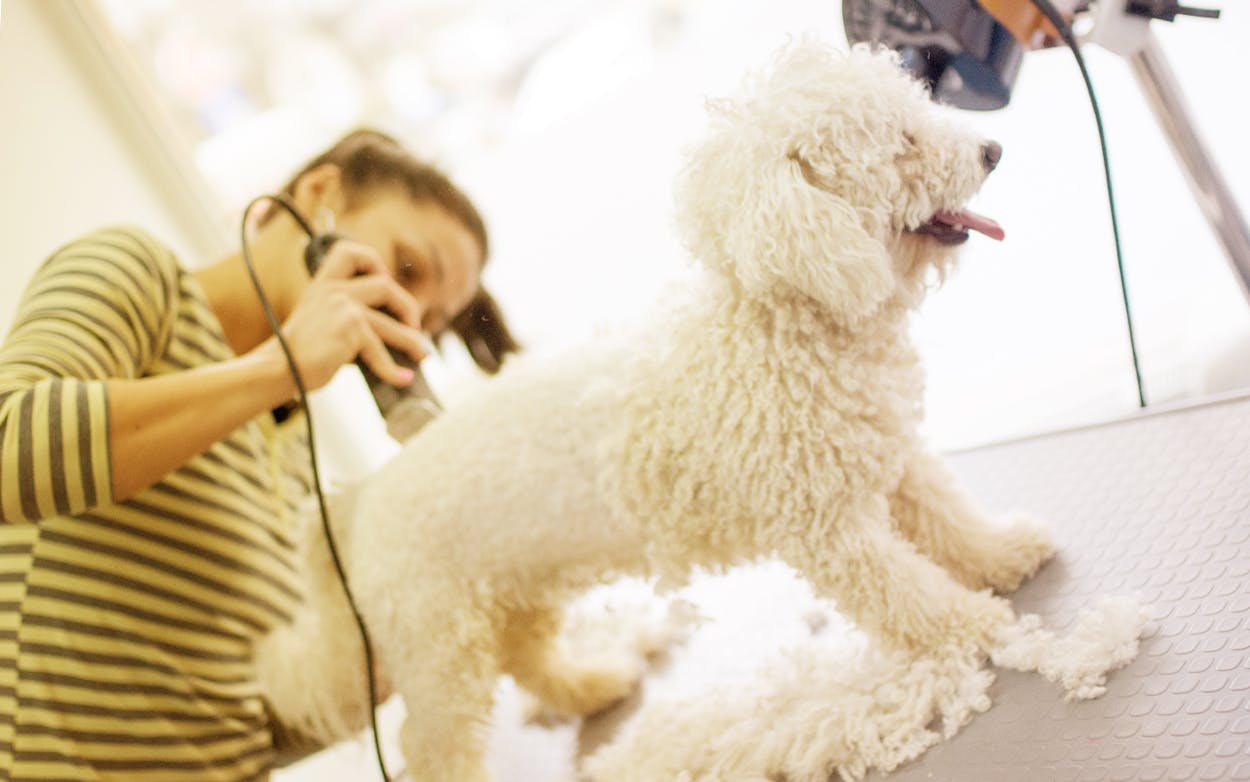Ten years ago, my wife and I saw a listing on Craigslist for an 18-month-old Siberian husky. Within a few seconds of meeting Dio, I knew he was our dog. In the years since, we’ve cared for him in little ways (a grain-free diet that agrees with his sensitive stomach!) and big ways (removing a tennis ball-sized tumor from his liver, as well as an actual tennis ball from his intestines that he somehow managed to swallow). But when you have a husky in the Texas summer, no matter how well you care for him, and no matter where he came from, strangers will say: “I bet he’s hot, huh?”
He is, in fact, hot. It’s Texas. The heat index this past week has been well over 100 degrees in Austin. We’re all hot. The thing is, he lives in a house with air-conditioning and plenty of water, with the added bonus of having no errands to run during the middle of the day. He goes for walks late at night or early in the morning, when the temperatures have dropped from “sweltering” to “just a little bit unpleasant.” And despite the heat, our answer to the frequent follow-up question—”Do you shave him in the summer?—is always no.
Generally speaking, shaving a dog in the summer ranges from unnecessary to an outright bad idea. The ASPCA advises against it for most breeds—and that’s especially true of huskies. They have a double coat that serves to insulate them from the heat, and helps to regulate their body temperature. Shaving double-coat dogs means robbing them of the insulation that keeps heat on the outside, and it’s unlikely to grow back evenly, which means that—at best—it’s an attempt to address a short-term problem that comes with long-term consequences. And it’s not just huskies like Dio with double coats; golden retrievers, labradors, German shepherds, and a whole lot of other breeds have them, too. And as the ASPCA also notes, dogs with thick coats naturally shed, and they tend to have lighter coats in the summer as a result.
Shaving a dog with a single coat, meanwhile, isn’t harmful. Poodles are frequently shorn, for instance, and those owners aren’t doing their dog a disservice—but it’s mostly for aesthetic value, as it still doesn’t completely keep them cool in the summer. (Though if the dog spends a lot of time lying on a tile floor in an air-conditioned environment, it might feel nice to have the cool ground directly on their skin.) That’s because dogs don’t sweat through their pores. When people see me and Dio walking around in the summer, they’ll often say things like, “I’d be miserable if I had to wear a big fur coat in this heat!” And that’s true of people. But the reason a big fur coat makes a human miserable in the summer is that it prevents heat from escaping their body, since humans release heat by sweating out of their skin. Instead, dogs release heat by sweating out of their tongue and their paws. If someone sees your dog on a hot day with his tongue lolling to the side, panting away, they needn’t assume that he or she’s miserable — that’s how they cool off.
Still, the idea that it’s cruel to have a cold weather dog in a place like Texas persists. I understand where that idea comes from—at Christmas, we’ll sometimes take Dio to my parents’ house in Indiana, and when he emerges from the car after a 16-hour drive to a winter wonderland of snow, he runs around like he’s just landed in Hawaii. But Dio was a rescue who had to be re-homed at 18 months, and he’s as much a native Texan as Juan Seguín, Lady Bird Johnson, and Willie Nelson. There are a lot of dogs who live in environments that aren’t ideal for their breed, and it’s not cruel to move a dog to a place like that, so long as you’re thoughtful about it. There are miserable malamutes in Alaska and happy, loved short-haired chihuahuas huddled around the fire during a Nova Scotia winter. The key, of course, lies in the people taking care of the pup.
The impulse to shave a dog comes from a place of compassion. People don’t suggest it because they want to see what a husky looks like with a sunburn—they do it because they think my dog will be more comfortable in the Texas heat with less fur. But compassion will also get a dog whose breed traits aren’t ideal for the summer through it, too. It means taking him for walks at midnight, and turning the thermostat down before leaving the house. It means letting him get some vitamin D by soaking in the sun even though it’s 100 degrees outside, and then putting some ice cubes in his water bowl. It’s something that you can’t solve with a one-time fix like a trip to the groomer, and instead requires the sort of ongoing attention that any pet deserves.
But it’s easy to do that for Dio, because he does stuff like that for us, too. My wife goes to sleep before I do, and Dio waits at the foot of the bed until I come in. In the fall and winter, when the weather is more suited to a husky’s natural sensibilities, we take long walks around our Austin neighborhood, and when we get to his favorite patio bar in the afternoon to watch football, he sits, alert, ready to bark at a rude drunk. If our pets are a part of our families—and Dio is certainly part of ours—then it’s easy enough to know how to make one comfortable in a less-than-ideal climate. Instead of listening to a random stranger—or even your own instincts about what would make you hot or cold—you just learn what they actually need, and then you do that.








